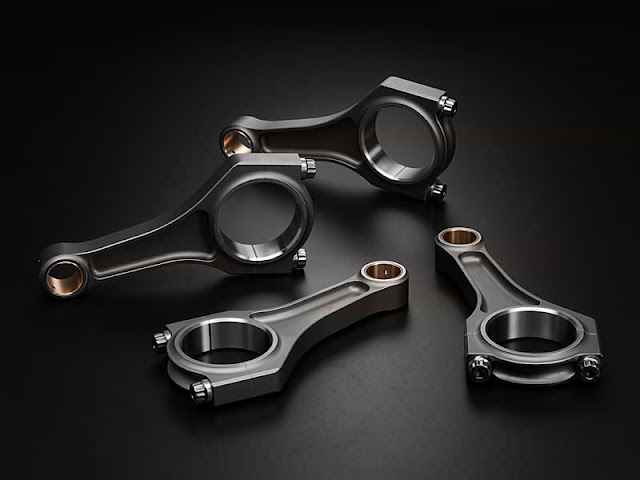The connecting rod is a piece of metal that connects the piston to the crankshaft. It connects the piston and cranks pin pins. The piston pin is attached to the small end of the connecting rod, whereas the crankpin is connected to the large end. The connecting rod's job is to transform the piston's linear motion into the rotating motion of the crankshaft.
Parts of Piston Connecting Rods
- Small End
The tiny end of the connecting rod is the end of the connecting rod joined to the piston pin's face.
- Wrist Pin
The engine piston is joined to the connecting rod by a wrist pin, a hollow hardened steel tube. The wrist pin pivots on the engaged piston and passes through the short end of the connecting rod.
- Big End
The large end of the connecting rod is the end of the connecting rod connected to the side of the crankpin.
- Bearing Cap
Shell bearings have a wear adjustment, but the running is controlled by the side clearance, enabling the bearing cap to be adjusted properly.
- Bolt and Nut
After the connecting rod is secured to the crank at the bottom, bolts and nuts are used to secure both sides of the huge ends. The piston connecting rod is ready to use by assembling all of these components.
The Types of Piston Connecting Rods
- Fork-Blade Rods
Split big-end rods, also known as fork blade rods, are used in V-twin motorcycle and V12 aviation engines. A forked rod is usually divided in two at the larger end for each pair of cylinders, and the blade rod from the adjacent cylinder is thinned to fit in the gap of the fork. This setup eliminates the rocking couple when the cylinder pairs are offset together with the crankshaft.
- Plain Type Rods
In inline and opposed engines, the simple connecting rod is used. The connecting rod's large end is linked to the crankpin and has a bearing cover. A bolt or stud secures the bearing cap at the end of the connecting rod. The piston connecting rod must be replaced in the same cylinder and relative position to ensure correct fit and balance.
- Powered Metal Conrods
Power metal is also used for connecting rods since it is a cost-effective option for producers. It is made by pressing a metal powder combination into a mould and heating it to a high temperature. This liquid is turned into a solid. It may need some mild machining, but it comes from a ready-to-use mould. Powder metal conrods are less expensive than steel and more durable than cast rods.
- Billet rods
Steel or aluminium is used to make billet connecting rods. They are lighter, stronger, and longer than other connecting rods. It is a popular choice for high-speed vehicles. It is sometimes made to eliminate stress risers and blend in with the billet with natural grain.
- Master and Slave Rods
Master-and-slave connecting rods are used in radial engines. In this design, one piston is made up of a master rod directly connected to the crankshaft. Other pistons attach their connecting rods to the rings that encircle the master rod's edge.
A piston engine's connecting rod links the piston to the crankshaft. The connecting rod turns the piston's reciprocating action into crankshaft rotation. As a result, in the current period, all sorts of machines rely on pistons, connecting rods, and crankshafts. These components are required for the internal combustion engine's exact operation.

Comments
Post a Comment